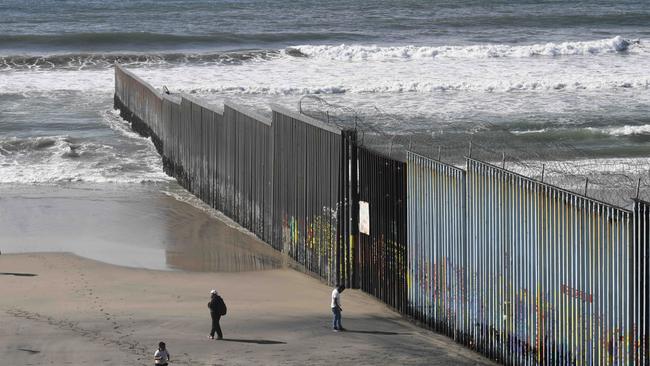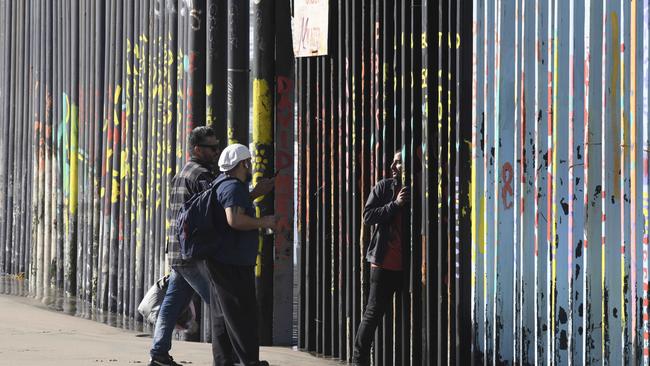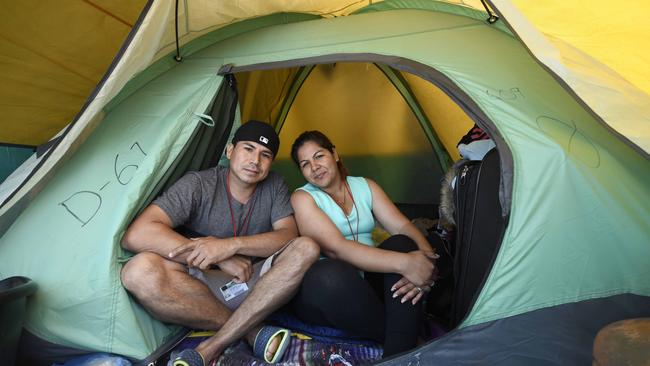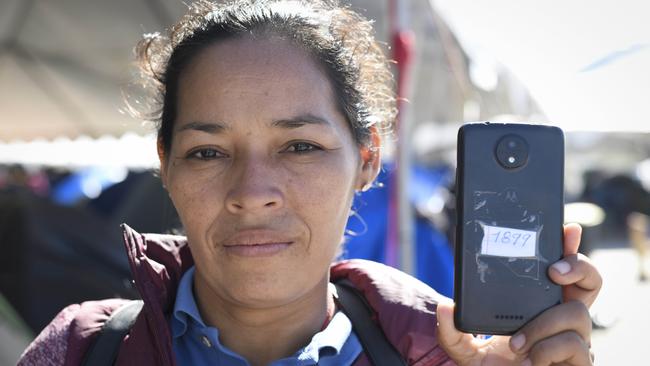When hope hits the wall
In a dusty migrant tent camp in Tijuana, Nicaraguan refugee Karen Macy explains her support for Donald Trump’s wall.

In the dusty migrant tent camp in the Mexican border city of Tijuana, Nicaraguan refugee Karen Macy talks about her dream of living in the US and her support for Donald Trump’s wall.
The 32-year-old single mother of four is not the sort of person you might expect to support tougher border controls when she herself may struggle to win asylum in the US. But Macy says she doesn’t believe in illegal immigration. She just wants the chance to be accepted into the US legally as an asylum-seeker.
“A lot of people in this camp do not like Donald Trump and his wall,” she says, as her three-year-old daughter Maria-Jose plays at her feet with a Barbie doll that is broken in two. But I understand if for security he wants to build a wall. The proper way to come into a country is to do it legally at the border entrance, not illegally by going through border fences.”
Macy says she walked for 15 days alone through the mountains of Nicaragua with her four children, aged three to 13, to get to Mexico late last year. She says she fled her home country because she was being persecuted for not supporting her government and was “constantly harassed by the military”.
She was one of the 6000 people who then joined the migrant “caravan” that travelled to Tijuana, on the border just south of San Diego in California.
She has been given a handwritten number — 1899 — which she has taped to the back of her phone and tells her how many people are in the queue before her to speak with US immigration authorities about a new life in America.
A few tents along, Luis Martinez, 35, and his girlfriend Teresa Lopez, 31, are planning a more dramatic entry into the US.
“I don’t think they will accept us because we don’t have enough ways to prove our story,” says Martinez, who says they escaped their native El Salvador because of violence, extortion and threats from gangs and because they want a better life in the US. So, rather than be rejected at the border by US authorities, he is planning to enter the country illegally.
“We will have to use smugglers to help us get across,” he admits.
They are waiting in the camp until a family friend in Los Angeles can raise the $US8000 ($11,270) needed to pay a smuggler to somehow get them across the border.
The contrasting approaches of Macy and Martinez, whose tents almost butt up against each other at Tijuana’s largest migrant camp, highlight the challenges for the Trump administration in crafting laws to deal with the almost 100,000 people who last year tried to claim asylum in the US, citing violence in their Central American homeland.
The issue is dominating US politics to the point of paralysis, given the US government remains in a record-length shutdown over funding for Trump’s proposed border wall.
Inquirer this week visited the migrant camps in Tijuana, home to the last caravan and one of the epicentres of what Trump has called the “humanitarian and national security crisis on our southern border”.
“Things have calmed down here a lot since November,” says local resident Daniel Martinez as he drives through Tijuana.
“It was a bit crazy there for a few weeks but now it’s back to normal, there is no crisis here.”
The crazy time he refers to was when this border city was overwhelmed by the arrival of the 6000-strong caravan, many of whom wrongly assumed they would be able to claim immediate asylum in the US.
Instead, they discovered the US system was far tougher and more complicated. A process called “metering”, used by the Trump administration but initiated by Barack Obama, deliberately limits the number of asylum-seekers the US is willing to meet with each day to discuss asylum claims.
With the US authorities in Tijuana willing to consider the claims of only 40 to 100 people on any given day, the migrants quickly realised they faced waits of many months.
These migrants — mostly from Honduras but also from El Salvador, Guatemala and Nicaragua — gathered in squalid makeshift camps in and around Tijuana where locals initially shunned many of them, fearing they brought violence and trouble to their city.
The migrants quickly became frustrated as word spread through the camps about how difficult it was to enter the US and about the raft of tougher measures introduced by Trump to deter asylum-seekers. In late November several hundred of them, including Luis Martinez, attempted a futile storming of the US border, rushing at the fence and forcing US border agents to fire tear gas at them.
“We ran at the border and then the helicopters and soldiers came,” recalls Martinez. The brief drama made headlines around the world and fuelled Trump’s claims of a crisis at the border.
Since then, life has returned to normal in Tijuana. The Mexican government was slow to respond to the arrival of the caravan but eventually secured new, larger shelters for the migrants.
The largest one, known as El Barretal, a former concert venue on the outskirts of the city, once held 3000 migrants. On the day Inquirer visits, it holds only 300, mostly families, sleeping in tents on a concert floor and fed by food provided by Mexican marines and charities.
Some have left because they have had their asylum claims heard and are in the US. Others have chosen to go home rather than wait for their turn, while others have secured jobs and accommodation in Tijuana. Those left are mostly waiting their turn on la lista — the list that determines when they can meet US border officials.
Mother of two Francisca Aguilar sits outside her tent playing with a white dog called Princess that she rescued from a beating by a local taco shop owner.
Since November she has been in the camp with her husband and two children, aged 15 and 18, after fleeing Honduras because her children were being forced to join violent gangs.
She says there are 1800 people ahead of her on la lista and that she has been looking around the streets nearby for a place where they can pitch their tent once this camp closes.
“I am worried that I will be deported when I (apply for asylum),” she says. Aguilar once lived in San Francisco as an illegal immigrant but was deported 25 years ago, leaving a then two-year-old boy in the US who she has lost touch with. This time she wants to enter the US legally but fears her previous deportation will work against her.
Nearby, Javier Contreras, 46, is also waiting for his turn to apply for asylum to be reunited with his wife and five children, who live in Fresno, California.
“I crossed the border illegally in 2003 and stayed until 2017,” when he left to visit his remaining family in El Salvador, he says. Now he wants to enter the US legally by claiming asylum.
He thinks he will be successful.

“I know Donald Trump does not want us in the US,” he says.
“But Trump also knows that he needs our labour — he needs people to work in the fields and in other jobs that Americans don’t want to do.”
A visit to these camps underlines several myths about the immigration debate in the US.
First, there is not, by any historical standard, a crisis on the border as Trump claims. The number of migrants apprehended for crossing the US border illegally has fallen by 75 per cent during the past 18 years — from 1.6 million in 2000 to just under 400,000 last year. The migrant camps on the border, as in Tijuana, are basic but orderly, with those migrants being given food and shelter while they wait.
The other myth is to say there is no problem.
The bigger policy challenge for the Trump administration is how to deal with the sharp rise in the number of people, especially families with children, who are claiming asylum because they say they are fleeing persecution.
Last year there was a dramatic surge in the number of migrants seeking asylum in the US, claiming they were fleeing violence and danger in their homelands in Central America. In 2008 just under 5000 migrants claimed the so-called “credible fear” justification, which under US law triggers the asylum process. By last year that number had soared to 97,000 — a 2000 per cent increase and a figure that has almost doubled in the past two years alone.
Refugee advocates say this reflects an upsurge in gang activity, violent crime and political instability across much of Central America. They say it also reflects a global trend, seen in Europe and Asia in recent years, of larger cross border movements to escape persecution and violence.
But the Trump administration smells a rat. It believes such a disproportionate increase in the numbers shows people are “gaming” the asylum system by pretending to use oppression to gain legal backdoor entry into the US.
The administration has responded by trying to narrow the criteria for asylum claims to those fleeing genuine persecution.
Last July then attorney-general Jeff Sessions introduced regulations making it impossible to gain asylum in the US by citing fears of domestic abuse or gang violence.
“An alien may suffer threats and violence in a foreign country for any number of reasons relating to her social, economic, family or other personal circumstances,” Sessions said at the time.
“Yet the asylum statue does not provide redress for all misfortune.”
Trump has struggled to implement other changes to slow down the acceptance of those seeking asylum from persecution.
Last June he was forced to end an order that anyone crossing the border illegally would be criminally prosecuted. Because many of those apprehended were families with children, this order resulted in the separation of those children from their parents, which sparked an outcry that forced Trump to back down.
The courts have blocked or are deliberating on two other Trump orders. The first was to deny asylum to anyone who crossed the US border away from the legal checkpoints. The second was to require asylum-seekers to stay in Mexico while their claims were being processed.
At the heart of this debate is the broader question of how the US will deal with asylum-seekers if the numbers continue to grow the way they have in the past two years.
How many is too many and how can the US impose orderly border security while still being consistent with the UN refugee protocols it signed in 1967?

It is the same question Australia and more recently Europe has grappled with when faced with a surge in asylum-seeker numbers.
In Tijuana, those who arrived in the caravan have met — or eventually will meet — US border officials. These officials will interview them and make an initial determination of whether there is a “credible fear” of returning to their homeland that triggers the asylum process.
Almost 90 per cent pass this initial test. Most are released into the US, some with a monitoring device around their ankle, to await their court case.
But with a backlog of about a million cases, it can take more than a year to have a court date with an immigration judge to determine an asylum claim.
Last year 28 per cent of those asylum-seekers did not turn up for their court case and are now illegal immigrants. This poor attendance rate may be partly explained by the fact only 17 per cent of those who did attend their court hearing last year had their asylum claims upheld. The rest were deported.
Trump’s proposed border wall would make it harder for migrants to cross the border illegally but the blended nature of border cities such as Tijuana make it impossible to guarantee anything like the border security enjoyed by an island continent such as Australia.
About 150,000 people pass through the border crossing at Tijuana each day. Many are Mexicans who work or even go to school in the San Diego, which lies just across the border, then return home to Tijuana at night.
It is the same at border towns such as El Paso and Laredo in Texas, where a steady stream of people and trucks crossing the border speaks to the intermeshed economic and social ties.
Laredo even shares a baseball team with its sister city across the border. If a Mexican wishes to start a new life in the US as an illegal immigrant they can simply cross the border legally, then melt away.

That is why opponents of Trump’s wall point out that, while almost 400,000 people were apprehended trying to cross the border illegally last year, more than 700,000 people entered the US legally and overstayed their visas.
Yet the debate over illegal immigration and the wall has taken its toll on many in Mexican border cities such as Tijuana.
Andrea Islas sits alongside the 9m steel fence that stretches along the border at Tijuana.
She says she no longer wants to live in the US after watching the debate unfold.
“It’s a hard topic,” says the 24-year-old freelance filmmaker who has lived in Tijuana all her life.
“Those people who came from Guatemala and Honduras, you see the desperation in their face. If they want to move to another country it won’t be for crime or for all the bad reasons Trump said, it will just be to have a better life.
“I wanted to go and live in America when I was younger but with everything now going on there and how they see us, it is not appealing to me any more.
“The US was the promised land, offering a better quality of life, but I’m not sure anymore. I don’t know, as a Mexican, how I would fit in.”
But few people in the Tijuana migrant camps seem to have reservations about wanting to live in the US, regardless of the controversy swirling around them.
Macy, the mother of four from Nicaragua who supports Trump’s wall, is confident she ultimately will be given a chance to start a new life in the US.
“Some people here don’t respect the laws of America but I do. America helps Nicaragua and I think America will help me also. I hope so,” she says.




To join the conversation, please log in. Don't have an account? Register
Join the conversation, you are commenting as Logout